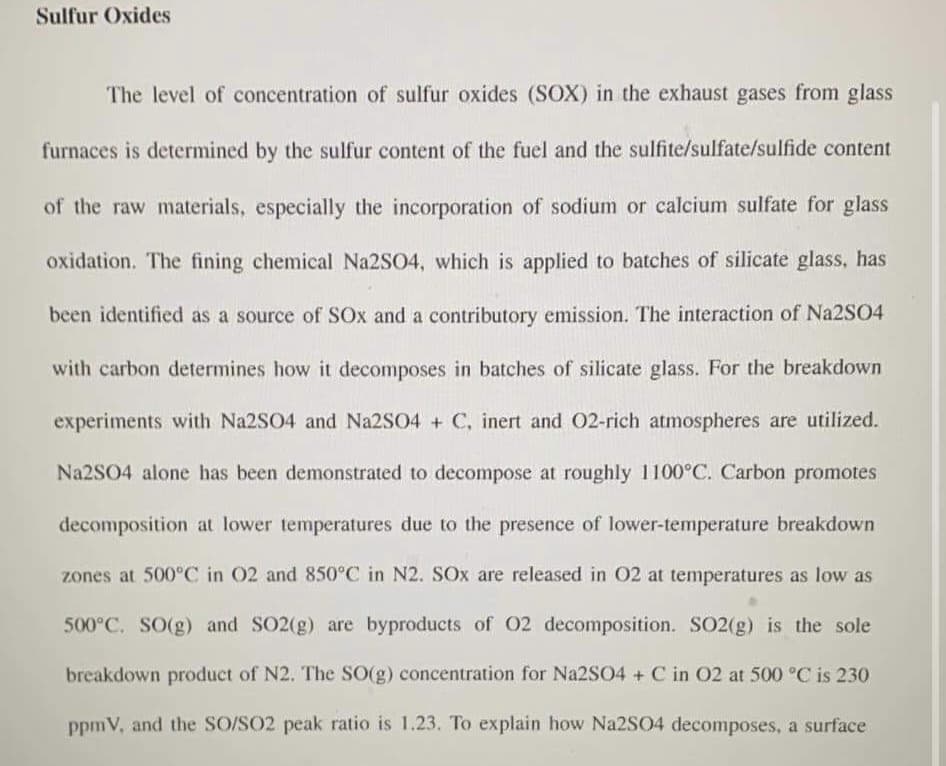The level of concentration of sulfur oxides (SOX) in the exhaust gases from glass furnaces is determined by the sulfur content of the fuel and the sulfite/sulfate/sulfide content of the raw materials, especially the incorporation of sodium or calcium sulfate for glass oxidation. The fining chemical Na2SO4, which is applied to batches of silicate glass, has been identified as a source of SOx and a contributory emission. The interaction of Na2SO4 with carbon determines how it decomposes in batches of silicate glass. For the breakdown experiments with Na2SO4 and Na2SO4 + C, inert and O2-rich atmospheres are utilized. Na2SO4 alone has been demonstrated to decompose at roughly 1100°C. Carbon promotes decomposition at lower temperatures due to the presence of lower-temperature breakdown zones at 500°C in O2 and 850°C in N2. SOx are released in 02 at temperatures as low as 500°C. SO(g) and SO2(g) are byproducts of 02 decomposition. SO2(g) is the sole breakdown product of N2. The SO(g) concentration for Na2SO4 + C in O2 at 500 °C is 230 ppmV, and the SO/SO2 peak ratio is 1.23. To explain how Na2SO4 decomposes, a surface
The level of concentration of sulfur oxides (SOX) in the exhaust gases from glass furnaces is determined by the sulfur content of the fuel and the sulfite/sulfate/sulfide content of the raw materials, especially the incorporation of sodium or calcium sulfate for glass oxidation. The fining chemical Na2SO4, which is applied to batches of silicate glass, has been identified as a source of SOx and a contributory emission. The interaction of Na2SO4 with carbon determines how it decomposes in batches of silicate glass. For the breakdown experiments with Na2SO4 and Na2SO4 + C, inert and O2-rich atmospheres are utilized. Na2SO4 alone has been demonstrated to decompose at roughly 1100°C. Carbon promotes decomposition at lower temperatures due to the presence of lower-temperature breakdown zones at 500°C in O2 and 850°C in N2. SOx are released in 02 at temperatures as low as 500°C. SO(g) and SO2(g) are byproducts of 02 decomposition. SO2(g) is the sole breakdown product of N2. The SO(g) concentration for Na2SO4 + C in O2 at 500 °C is 230 ppmV, and the SO/SO2 peak ratio is 1.23. To explain how Na2SO4 decomposes, a surface
Chemistry
10th Edition
ISBN:9781305957404
Author:Steven S. Zumdahl, Susan A. Zumdahl, Donald J. DeCoste
Publisher:Steven S. Zumdahl, Susan A. Zumdahl, Donald J. DeCoste
Chapter1: Chemical Foundations
Section: Chapter Questions
Problem 1RQ: Define and explain the differences between the following terms. a. law and theory b. theory and...
Related questions
Question
Please explain the photo attached

Transcribed Image Text:reaction that results in the creation of SOx by rearranging active S-O complexes on the melt
surface of Na2SO4 can be employed. throughout isothermal decomposition at 1200 °C.
Na2SO4 + C in N2 exhibits considerable mass loss throughout the heating-up phase and a
zone of higher decomposition rate at shorter periods. Over extended periods of time, the rate
of decomposition is equivalent to that of Na2SO4.

Transcribed Image Text:Sulfur Oxides
The level of concentration of sulfur oxides (SOX) in the exhaust gases from glass
furnaces is determined by the sulfur content of the fuel and the sulfite/sulfate/sulfide content
of the raw materials, especially the incorporation of sodium or calcium sulfate for glass
oxidation. The fining chemical Na2SO4, which is applied to batches of silicate glass, has
been identified as a source of SOx and a contributory emission. The interaction of Na2SO4
with carbon determines how it decomposes in batches of silicate glass. For the breakdown
experiments with Na2SO4 and Na2SO4 + C, inert and O2-rich atmospheres are utilized.
Na2SO4 alone has been demonstrated to decompose at roughly 1100°C. Carbon promotes
decomposition at lower temperatures due to the presence of lower-temperature breakdown
zones at 500°C in O2 and 850°C in N2. SOx are released in 02 at temperatures as low as
500°C. SO(g) and SO2(g) are byproducts of 02 decomposition. SO2(g) is the sole
breakdown product of N2. The SO(g) concentration for Na2SO4 + C in O2 at 500 °C is 230
ppmV, and the SO/SO2 peak ratio is 1.23. To explain how Na2SO4 decomposes, a surface
Expert Solution
This question has been solved!
Explore an expertly crafted, step-by-step solution for a thorough understanding of key concepts.
Step by step
Solved in 3 steps

Knowledge Booster
Learn more about
Need a deep-dive on the concept behind this application? Look no further. Learn more about this topic, chemistry and related others by exploring similar questions and additional content below.Recommended textbooks for you

Chemistry
Chemistry
ISBN:
9781305957404
Author:
Steven S. Zumdahl, Susan A. Zumdahl, Donald J. DeCoste
Publisher:
Cengage Learning

Chemistry
Chemistry
ISBN:
9781259911156
Author:
Raymond Chang Dr., Jason Overby Professor
Publisher:
McGraw-Hill Education

Principles of Instrumental Analysis
Chemistry
ISBN:
9781305577213
Author:
Douglas A. Skoog, F. James Holler, Stanley R. Crouch
Publisher:
Cengage Learning

Chemistry
Chemistry
ISBN:
9781305957404
Author:
Steven S. Zumdahl, Susan A. Zumdahl, Donald J. DeCoste
Publisher:
Cengage Learning

Chemistry
Chemistry
ISBN:
9781259911156
Author:
Raymond Chang Dr., Jason Overby Professor
Publisher:
McGraw-Hill Education

Principles of Instrumental Analysis
Chemistry
ISBN:
9781305577213
Author:
Douglas A. Skoog, F. James Holler, Stanley R. Crouch
Publisher:
Cengage Learning

Organic Chemistry
Chemistry
ISBN:
9780078021558
Author:
Janice Gorzynski Smith Dr.
Publisher:
McGraw-Hill Education

Chemistry: Principles and Reactions
Chemistry
ISBN:
9781305079373
Author:
William L. Masterton, Cecile N. Hurley
Publisher:
Cengage Learning

Elementary Principles of Chemical Processes, Bind…
Chemistry
ISBN:
9781118431221
Author:
Richard M. Felder, Ronald W. Rousseau, Lisa G. Bullard
Publisher:
WILEY